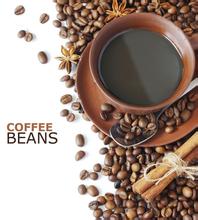What are the advantages of high-altitude coffee beans? what are the differences in the flavor of different varieties of coffee beans at different elevations?
Introduction of High altitude Coffee Bean
Generally speaking, with the increase of altitude, the aroma of coffee becomes more and more prominent and unique (see figure). From the temperature and sweetness of Brazilian beans at 3500 feet to the soaring taste of Ethiopian coffee beans above 6000 feet, altitude will give better play to the complex and subtle taste of coffee beans grown at high altitude. coffee beans are hard and dense and have the potential to develop a special flavor. The really amazing coffee growing areas are between 4000 and 6000 feet above sea level, and these beans are picked carefully only during the mature season. Coffee in Central America is rated according to the altitude at which it grows. For example, SHB (Strictly Hard Bean) is the term for Guatemalan coffee beans, indicating that coffee grows above 4500 feet. Mexico is called Altura, which means "high" in Spanish, indicating that it is high-altitude coffee; Papua New Guinea adds the name "Mile High" to mark coffee beans grown in the highlands and mountains.
Generally speaking, with the increase of altitude, the aroma of coffee becomes more and more prominent and unique (see figure). From the temperature and sweetness of Brazilian beans at 3500 feet to the soaring taste of Ethiopian coffee beans above 6000 feet, indicating that the increase in altitude will enable coffee beans to give better play to the complex and subtle taste of coffee beans grown at high altitude. coffee beans are hard and dense and have the potential to develop a special flavor. The really amazing coffees are grown between 4000 and 6000 feet above sea level, and these beans are picked carefully only during the mature season. Coffee in Central America is rated according to the altitude at which it grows. For example, SHB (Strictly Hard Bean) is the term for Guatemalan coffee beans, indicating that coffee grows above 4500 feet. Mexico is called Altura, which means "high" in Spanish, indicating that this is high-altitude coffee; Papua New Guinea adds the name "Mile High" to mark coffee beans grown in the highlands and mountains 3000-6000 feet above sea level provide ideal conditions for coffee to grow: an average year-round frost-free climate of 60-70 degrees Fahrenheit, about 80 inches of moderate rainfall, and abundant sunshine. Coffee beans grow slowly in cold mountain areas, but the slow ripening process makes coffee beans have higher sugar content, more interesting flavor and mellow flavor. At high altitude, the displacement is high, and the fruit taste is more concentrated. The best Arabica coffee growing areas have very fertile soil and often have a profound impact on the flavor of coffee beans in volcanic areas. All coffee grows in the tropics, and the altitude at which it grows has a profound effect on the taste of the coffee. From the tropics to 30 degrees north latitude and the mountains south of the equator produce the world's truly high-quality Arabica coffee. Central and South America, South Asia and some Pacific islands, and south-central Africa are also the most important coffee-growing areas in the world.

Important Notice :
前街咖啡 FrontStreet Coffee has moved to new addredd:
FrontStreet Coffee Address: 315,Donghua East Road,GuangZhou
Tel:020 38364473
- Prev

Why do high-altitude coffee beans taste sour? What is the flavor difference between highland coffee and regular coffee
Why do high-altitude coffee beans taste sour? Generally speaking, the more deeply roasted coffee beans, the less sour, or even none, and show another kind of pure coffee characteristics. After roasting, the acid content of raw coffee beans changed greatly, among which the change of volatile acid was the biggest. So today, when we are still in the habit of deep baking, it is very difficult for us to learn from
- Next

The brewing method of coffee grinding powder? Introduction to hand-made coffee
Coffee brewing way in the way of actual cooking, the time required for ESPRESSO machine to make coffee is very short, so the coffee powder is as fine as flour; it takes about 1-3 minutes to siphon coffee, and the coffee powder is medium-thick grinding; the American coffee maker and hand-brewing filter generally have a coarse and fine degree of sugar. Proper coffee powder research
Related
- Guji coffee producing area of Guji, Ethiopia: Humbela, Shakiso, Wulaga
- What is the most expensive variety of Qiloso in BOP multi-variety group?
- How to store the coffee beans bought home?
- Why are Yemeni coffee beans so rare now?
- Ethiopian Sidamo all Red Fruit Sun Sun Santa Vini Coffee beans
- SOE is mostly sour? What does it mean? Is it a single bean? what's the difference between it and Italian blending?
- Is Italian coffee beans suitable for making hand-brewed coffee?
- How to choose coffee beans when making cold coffee? What kind of coffee beans are suitable for making cold coffee?
- Just entered the pit to make coffee, what kind of coffee beans should be chosen?
- Can only Japan buy real Blue Mountain Coffee? What are authentic Jamaican Blue Mountain coffee beans?

